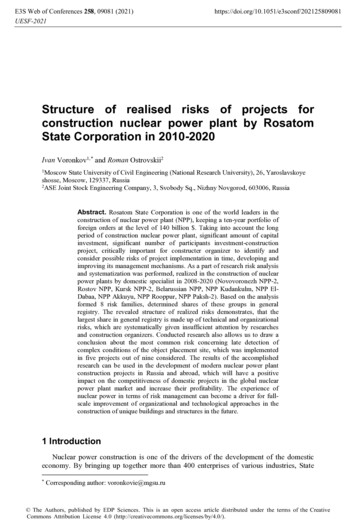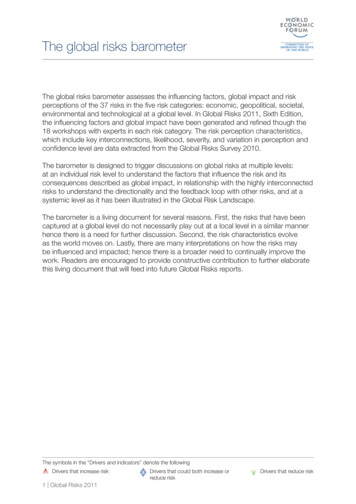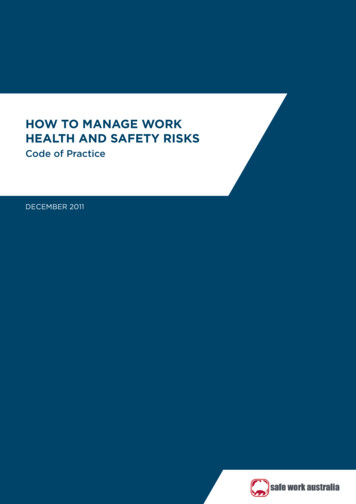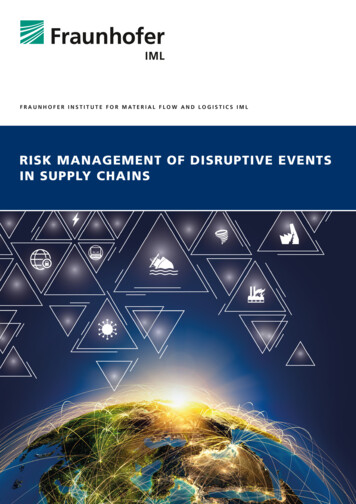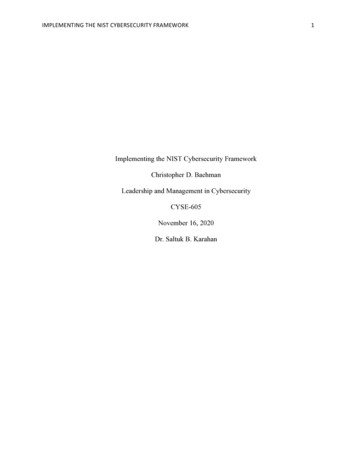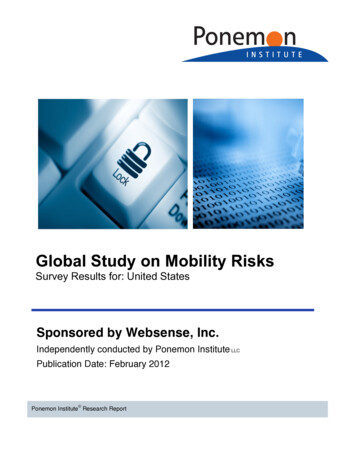
Transcription
Global Study on Mobility RisksSurvey Results for: United StatesSponsored by Websense, Inc.Independently conducted by Ponemon Institute LLCPublication Date: February 2012 Ponemon Institute Research Report
1Global Study on Mobility RisksSurvey of IT & IT Security Practitioners in the United StatesExecutive SummaryFebruary 2012Part 1: IntroductionMobile devices are a mixed blessing for employees, and a mixed blessing for organizations, butfor different reasons. Smartphones allow workers much more flexibility in managing theirschedules, but at the cost of always finding themselves at work. Who among us has notanswered work emails from the dinner table, waiting in line at a store, even from the car, andprobably every room of the house?And organizations reap huge benefits from having near-instant responses even outside of workhours, but they simultaneously open the door to unprecedented loss of sensitive data. As laptops,iPhones, Androids, iPads, and USB drives increase in sophistication, they can do more and more,and they become more and more popular, but they also greatly increase the risk to anorganization’s networks, sensitive data, and ultimately, profits and reputation.1And so it is little wonder that quite a few security experts have designated smartphones andother mobile devices as one of the most serious threat vectors for an organization. This ispartially due to the nomadic work life of employees. Sensitive data on mobile devices travels—physically and electronically—from the office to home and other off-site locations. According to aprevious Ponemon Institute study of 116 organizations, 62 percent of mobile data-bearing2devices that were lost or stolen contained sensitive or confidential information.On the electronic front, mobile attacks are getting more sophisticated and effective. In the comingyear, we expect to see targeted device attacks from malware, spyware, maliciousdownloads/mobile apps, phishing, and spam. Because of their ubiquity and disruptive growth,Androids and iPhones have emerged as particularly popular platforms for attack.To help IT security professionals plan for an increasingly mobile electronic workforce, Websense,Inc. and Ponemon Institute have created this Global Study on Mobility Risks. We define mobiledevices as laptops, USB drives, smartphones and tablets.We surveyed 4,640 IT and IT security practitioners in the United States, United Kingdom,Australia, Brazil, Canada, France, Germany, Hong Kong, Italy, India, Mexico, and Singapore.Fifty-four percent are supervisors or above, 42 percent are employed by organizations with morethan 5,000 employees, and they have an average tenure of 10 years. In this report we feature asummary of findings from the 601 respondents who participated in the U.S. study.Part 2. Key Findings Due to the importance of mobile devices for business reasons, more organizationsneed to have the necessary security controls in place. Sixty-nine percent of respondentssay that employee use of mobile devices is essential or very important to their organization’sability to meet its business objectives. Seventy-four percent acknowledge that employee useof these devices represents a serious risk to their organizations. Because of their manybenefits, mobile devices will continue to be ubiquitous in the workplace. Restricting their use1Dr. Larry Ponemon and Stanton Gatewood, Ponemon’s Predictions: Trends in IT Security, Webinar sponsored byArcSight, May 17, 20112Ponemon Institute’s security tracking study of 116 global companies with a special carve-out on mobile-connecteddevices used by employees, conducted September 2010 through March 2011Ponemon Institute Research ReportPage 1
2is not an option, so organizations need to address the risk through policies, processes, andenabling technologies. Insecure mobile devices—including laptops, smartphones, USB devices, and tablets—increase rates of malware infections. Sixty percent of respondents say that over the past12 months, their organizations experienced an increase in malware infections as a result ofinsecure mobile devices in the workplace, with another 21 percent unsure.Thirty-two percent of respondents say that mobile devices are responsible for an increase ofmore than 50 percent in malware infections. Eleven percent does not know. Many organizations had data loss or serious exploits resulting from employee use ofinsecure mobile devices. Fifty-one percent of respondents say that their organizationsexperienced a data breach due to insecure mobile devices, and 23 percent are unsure. Wealso asked respondents to indicate the consequences of mobile data breaches. Forty-twopercent say it was theft, removal, or loss of information and/or other resources and 35percent say it was disclosure of private or confidential information. The majority of organizations do not have a policy that addresses the acceptable orunacceptable use of mobile devices by employees. Sixty-five percent of respondents saythat their organizations do not have a policy that addresses the acceptable or unacceptableuse of mobile devices by employees or they are unsure. Of the 35 percent who report theirorganization has a policy, 48 percent say the policy is not enforced and 18 percent areunsure.We asked those respondents who said that there is no enforcement of these policies toprovide the reasons. Primarily it is due to lack of governance and oversight (55 percent) andbecause other security issues are a priority (46 percent). Forty percent cite insufficientresources to monitor compliance. Security settings and controls at the device level are required in many organizationsbut are often turned off. Fifty-one percent of organizations require mobile devices used inthe workplace to have appropriate security settings and controls at the device level. Fortypercent do not require security settings and 9 percent are unsure. Of those organizations thatrequire security settings and controls, only 3 percent say that all employees are compliantand 18 percent do not know.Sixty percent say that their employees circumvent or disengage security features such aspasswords and key locks. Only 28 percent say employees are compliant and do not engagein this practice. Twelve percent are unsure. A decrease in employee productivity followed by diminished bandwidth areconsidered the most negative consequences of insecure mobile devices. Seventypercent say that a diminishment in employee productivity, as a result of insecure mobiledevices, has already occurred or is very likely to occur. Sixty-nine percent of respondents saya top negative consequence of mobile devices is keeping up with the need to increasebandwidth. This is likely due to the explosion in mobile media and the sharing of videos,music, and applications. Fifty-four percent of respondents believe that a negativeconsequence that has already happened or is likely to happen is an increase in malwareinfections.Ponemon Institute Research ReportPage 2
3 To mitigate the risks created by mobile devices, certain technologies are preferred.The technologies considered essential or very important by respondents are: device levelencryption, endpoint security solution, and anti-malware.According to Websense, many companies make significant investments in encryption andendpoint security to protect sensitive data, but they often don’t know how/what data is leavingthrough insecure mobile devices. Traditional static security solutions such as antivirus,firewalls, and passwords are not effective at stopping advanced malware and data theftthreats from malicious or negligent insiders. To safely permit corporate use of mobile devices,organizations need data loss prevention technology that knows where critical data is saved,who is accessing it, how it’s attempting to leave, and where it’s going.Real-time malware intelligence is also necessary because cybercriminals change their tacticsfaster than traditional security updates are pushed out. Websense recommends thatorganizations proactively deploy real-time anti-malware technology via cloud services thatcontinually analyzes and re-analyzes websites and mobile applications. Using cloud securityservices enables organizations to protect remote users anytime and anywhere. For moreinformation, read “A 3-Step Plan for Mobile Security.” The use of personal mobile devices is putting organizations at risk. Eighty-five percentof respondents say that their organizations allow employees to use their personal devices toconnect to corporate email. Seventy-two percent permit access to business applications and69 percent permit connection to personal (web-based) email.According to respondents, personal devices are posing just as much risk as insecurecorporate mobile devices. Fifty-six percent say that their organization has experienced anincrease in malware infections as a result of personally owned mobile devices used in theworkplace. Fifty-five percent say that more confidential data has been lost as a result of thesedevices, while 24 percent are unsure. Organizations worry about employees using their mobile device to take photos orvideos in the workplace. Sixty-eight percent of respondents say that this practice is frownedupon by their organizations and is considered unacceptable. Other unacceptable practicesinclude using personal email accounts (45 percent) and downloading and using internet apps(42 percent).Part 3: Summary and recommendationsIn every part of the globe, IT and IT security practitioners recognize the positive impact thatmobility brings to productivity. Benefits include 24/7 access to email, corporate documents, andother essential information. The challenge is how to ensure that mobile device use does notjeopardize the security of sensitive and confidential information.Here are five recommendations on how to effectively manage security technology and enjoy thebusiness benefits of mobile devices: Understand the risk that mobile devices create in the workplace. Conduct a risk assessmentto understand what practices may be putting your organization at risk, such as storing largeamounts of confidential data that are at high risk for data leakage and loss. Educate employees about the importance of safeguarding their mobile devices. Riskybehavior includes downloading apps and free software from unsanctioned online stores thatmay contain malware, turning off security settings, not encrypting data in transit or at rest,Ponemon Institute Research ReportPage 3
4and not promptly reporting lost or stolen devices that may contain confidential and sensitiveinformation. Create a comprehensive mobile device policy (including detailed guidelines) for allemployees and contractors. The policy should address the risks and the security proceduresthat should be followed. Use enabling technologies to detect and prevent data theft and mobile malware danger.Implement layers of security where device management capabilities are supplemented byadvanced secure access controls, threat protection provided by cloud services, and data theftprotection at the endpoint to identify valuable intellectual property and protect it. Use policy controls to keep productivity and resource utilization in check.Ponemon InstituteAdvancing Responsible Information ManagementPonemon Institute is dedicated to independent research and education that advances responsibleinformation and privacy management practices within business and government. Our mission is to conducthigh quality, empirical studies on critical issues affecting the management and security of sensitiveinformation about people and organizations.As a member of the Council of American Survey Research Organizations (CASRO), we uphold strictdata confidentiality, privacy and ethical research standards. We do not collect any personally identifiableinformation from individuals (or organization identifiable information in our business research). Furthermore,we have strict quality standards to ensure that subjects are not asked extraneous, irrelevant or improperquestions.Ponemon Institute Research ReportPage 4
encryption, endpoint security solution, and anti-malware. According to Websense, many companies make significant investments in encryption and endpoint security to protect sensitive data, but they often don't know how/what data is leaving through insecure mobile devices. Traditional static security solutions such as antivirus,

